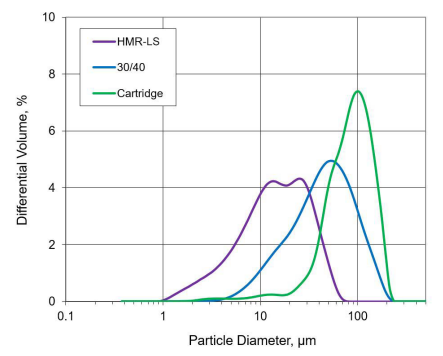Enhanced TDS
Knowde-enriched technical product data sheet
Identification & Functionality
- Chemical Family
- Chemical Name
- Industrial Additives Functions
- Molecular formula
- MgO-x SiO₂ – y H₂O
- EINECS No.
- 2156811
- Technologies
- Product Families
Features & Benefits
- Industrial Additives Features
- Benefits of Magnesium Silicate Adsorbents
Adsorbent type and adsorbent dose are two of the most important factors influencing the residual potassium content for specific polyols. IAM MultiFunctional adsorbents have excellent capability for color removal from polyols and surfactants. Color may be lowered below 30-50 APHA during the purification process. Removal of potassium and sodium catalysts below 20 ppm significantly improves color of final product.
IAM MultiFunctional adsorbents provide:
- Low residual potassium content to help meet polyol and surfactant specifications
- 25-40% less adsorbent dose requirement which can reduce filter cake disposal
- Lower pH of treated polyol which can improve or eliminate the neutralization step
- Faster filtration time which improves productivity
- Excellent color removal for improved polyol quality
Applications & Uses
- Markets
- Applications
- Applicable Processes
- Industrial Additives End Use
- Use Level
- 1 - 3 wt %
- Product Selection Guide
Product HMR Polysorb 30/40 Cartridge Grade KOH adsorption* - dry 210 190 185 KOH adsorption* - wet 220 210 210 Filtration rate Standard Moderate Fast *KOH adsorption is determined in a special laboratory test utilizing di-propylene glycol (DPG) as a model polyol.
General guidance for adsorbent selection:
- If the polyol has a molecular weight below 1000, pH above 12, and low viscosity, then HMR and Polysorb 30/40 will be the adsorbents of choice to achieve potassium content below 5 ppm
- If the polyol has a molecular weight between 1000-5000, high pH, and high viscosity, then Polysorb 30/40 and Cartridge Grade will be more preferential adsorbents for potassium and color removal.
- Cartridge Grade is recommended to use when high filtration rate is required, specifically when pressure leaf filters with centrifugal discharge are used.
- Applications
- Adsorbent for the purification of polyols & surfactants
- Filter aid, Catalyst supports, Carriers, Reinforcing fillers
Properties
- Physical Form
- Taste
- Tasteless
- Odor
- Odorless
- Appearance
- White powder
- Insoluble in
- Water
- Typical Properties
Value Units Test Method / Conditions Surface Area, BET 350 m²/g - pH 9.7 - - Particle Size (Mean diameter of Volume distribution) 50 microns - KOH Adsorption* 190 mg/g - - Assay
Value Units Test Method / Conditions SiO₂ (Ignited Basis) min. 67.0 % - MgO (Ignited Basis) min. 15.0 % - - Specifications
Value Units Test Method / Conditions Soluble Salts max. 3.0 % - SO₄ Content max. 2 wt % - Magnesium Silicate 73 % - Loss on Ignition (at 900°C, dry basis) max. 15.0 % - Loss on Ignition (at 900°C) 25 % - Loss on Drying (at 105°C, as packaged) max. 20.0 % - KOH Adsorptivity min. 180 mg KOH/g Magnesol® - Free Alkali (as NaOH) max. 1.0 % - DPG Filter Time max. 150 s - - Note
* KOH adsorption is determined in a special laboratory test utilizing di-propylene glycol (DPG) as a model polyol.
Regulatory & Compliance
- Certifications & Compliance
- Chemical Inventories
Technical Details & Test Data
- Particle Size Distribution
Typical Particle Size Distribution of MAGNESOL® adsorbents used for polyol

- Operating Conditions Effect on Adsorbent Performance
- Addition of water to the polyol-adsorbent suspension prior to heating and filtration promotes and accelerates removal of the catalyst from the crude polyether polyols. Water addition enhances potassium transfer from the polyol phase to the water phase and promotes activation of sites on the surface of the adsorbent in the process of polyol purification.
- Water addition of 0.3% or greater in some polyols can significantly increase the performance of IAM MultiFunctional adsorbents. The optimum water concentration can be determined in the laboratory or in pilot plant tests. If water addition is used to enhance adsorption, a dehydration step is required to achieve a water specification in the finished polyol.
- The typical polyol treatment temperature varies from 85°C to 140°C and depends on the polyol chemistry, viscosity, and process conditions. The optimum treatment temperature will vary with each process. In general, the higher the treatment temperature, the better the efficiency of polyol purification with synthetic magnesium silicate adsorbents. Therefore, at higher temperature, the adsorbent dose amount can be reduced. Higher temperature is desirable as long as the polyol is not adversely affected, and process safety criteria are not violated.
- After completion of polyol purification by adsorption, IAM MultiFunctional adsorbents are separated from the polyol by filtration using an appropriate filtration equipment.
- The typical polyol purification process requires from 4 to 6 hours of operation and uses 6 separate steps in sequence:
- IAM MultiFunctional adsorbent addition to neutralization vessel.
- Mixing adsorbent slurry with agitation only.
- Water addition to agitated polyol slurry.
- Filtration with polyol recirculation through the filter.
- Dehydration (stripping) to control residual water content.
- Transfer polyol to finished vessel through the filter.
- In some cases, specifically for hydrophobic polyols and non-ionic surfactants, the water addition step can substantially improve not only catalyst removal efficiency, but also polyol filtration time due to the viscosity reduction and adsorbent particles coagulation and agglomeration in the filter cake.
- Sodium hydroxide is also used as the catalyst for polymerization reaction in polyol and surfactant production. Affinity of magnesium silicate adsorbents for sodium removal is lower than that of potassium due to the ion hydration effect.